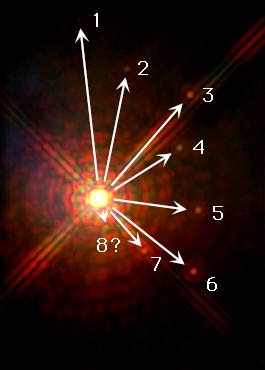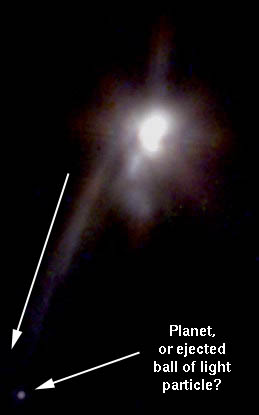In the history of astronomy, there have been very few areas of research that have received as much effort as explaining how the galaxy formed. With all of that history, with all of that work, I regretfully have to explain how the Ball-of-Light Particle Model predicts a dramatically different picture.
The classical theory of how the planets where formed goes something like this:
- There was a cloud of primordial dust and gas.
- It was not smoothly distributed
- It started to contract due to gravity
- The lumps in the cloud of material caused contractions that were more dense than in other areas of the cloud of material
- The cloud, for some reason, started to rotate in one direction
- The rotation, combined with gravitational contraction, made the cloud collapse into a disk shape
- During collapse, the biggest clump of material in the center became heated and formed the sun
- During collapse, the smaller clumps of material became the planets
- For some reason, almost all of the planets began to rotate in the same direction
- For some reason, some of the planets develop rings
- For some reason, the planets develop different compositions (The terrestrial planets are much more rocky, the Jovian planets are much more gaseous.)
- For some reason, the planets became spaced in a fairly regular spacing where the orbit of each planet is roughly twice as for out as the next.
- And finally, for the major details at least, the angular momentum of the collapsing cloud somehow became about 400 times greater in the planets than in the sun.
The Ball-of-Light Particle Model predicts the Solar System was created this way:
- The core of the galaxy -- a ball-of-light -- ejected the core of our sun -- another ball-of-light
- The sun had a high angular momentum due to how it was ejected from the core of the galaxy
- The sun's core started to decay -- primarily in the "fizzle" decay mode -- creating an envelope of material around the core, and a spherical cloud of material consisting of: normal elementary particles; and small decaying balls-of-light that eventually cooled into the materials that now make the non-planar comets and asteroids (To be explicit: the core of the sun made a cloud of gas and dust, not a cloud of gas and dust made the sun.)
- The sun's velocity with respect to the center of the galaxy started to slow due to gravitational interaction between the sun and the central mass of the galaxy
- As the sun slowed, it became less stable
- At one point, a massive instability on the surface of the sun's core started to develop because of the slowing of the sun's motion relative to the center of the galaxy
- The core ejected a ball-of-light -- in the "split" decay mode -- that reduced the instability and the angular momentum of the sun
- The core ejected another ball-of-light -- in the "split" decay mode -- again reducing the instability and further reducing the angular momentum of the core
- This process continued until the core became stable and lost almost all of its angular momentum
- Each ejected ball-of-light was ejected along the plane of the sun's rotation
- Each ejected ball-of-light was ejected with the same direction of angular momentum
- Balls-of-light that were ejected earlier, were ejected with more energy, and developed larger orbits (because the core of the sun was more unstable early)
- Balls-of-light that were ejected later in the sequence, were ejected with less energy, and developed smaller orbits (because the core was more stable later)
- Each ejected ball-of-light had a range of stability between very stable to very unstable
- Each ejected ball-of-light had a different pattern of electric and magnetic wave patterns on its core
- As each ejected ball-of-light decayed, they induced elementary particles (To be explicit: the core of each ejected ball-of-light made a small cloud of gas and dust, not clumps within a large cloud of gas and dust made the planets.)
- The types of elementary particles that were induced by these ejected balls-of-light depended upon the unique pattern of harmonic electric and magnetic waves on the core's of the ejected balls-of-light (An ejected ball-of-light with very harmonic patterns induced elementary particles like Hydrogen and Helium. Ejected balls-of-light with less harmonic patterns induce heavier elements like silicon and iron.)
- The decaying balls-of-light eventually either: fizzled out, split, disked, or exploded
- The balls-of-light of that quickly fizzled -- were more unstable, thus creating on the average more heavier elements -- became terrestrial planets
- The balls-of-light that slowly fizzled -- were more stable, thus creating on the average more lighter elements -- became Jovian planets
- The planetary balls-of-light that decayed with a disk pattern developed disks
- One possible ball-of-light decayed explosively leaving behind a planar band of smaller chunks of material and asteroids in an orbit between Mars and Jupiter
- At some point in the decay of some of the planetary balls-of-light, they decayed with a split pattern, thus creating moons
- Some smaller balls-of-light slowly decayed and were gravitationally captured by larger planets, thus becoming moons
- Some of the balls-of-light collided, thus creating unusual situations such as Neptune's tumbling orbit
- Some of the normal elements -- such as hydrogen, helium, ... uranium -- in the small clouds around each ejected ball-of-light were gravitationally accreted in the fashion of "traditional" planetary formation theory.
There is such a discrepancy between the traditional view of creation for the Solar System and the Ball-of-Light Particle Model's description, that if this new model is correct, then it surely will hurt the feelings of those who have worked so hard on the older models.
Problems with the traditional view of Planetary Formation
To many scientists it probably seems like the theory of planetary formation is a "done deal." In other words, there is no reason to doubt it. Actually, many new observations are revealing major problems with the traditional view of planetary formation.
For example, traditional theory states that large planets -- such as Jupiter -- can not form close to a star because close in there isn't enough gas and dust, and the high temperature of the central star would prevent the material from coalescing. They must form further out where most of the cool gas and dust of a young solar system that is capable of gravitationally coalescing would be found.
Also, traditional theory states that the planets should have circular orbits since as the primordial cloud of gas and dust collapsed, the cloud would start rotating faster -- much like a skater or a diver spins faster as the arms are pulled in. In such a scenario, there would be no reason for the orbits to be very elliptical.
The most confounding observations that are throwing planetary formation theory into confusion, are the newly descovered planets around other local stars. Two of the planets discovered around other stars have very elliptical orbits. Five of the huge planets discovered -- 51 Pegasi, 55 Cancri, Tau Bootis, Upsilon Andromedae, and Rho Coronae Borealis -- have orbits very close to their parent stars -- in the region where traditional theory states they can not form.
Example of a star ejecting smaller balls-of-light
In this Hubble Space Telescope image of a star in the Cone Nebula there are small balls-of-light around the parent star. The Ball-of-Light Particle Model predicts they were ejected by the central star. If they quickly decay, they may eventually form planets like Mercury. If they slowly decay, they may eventually form planets like Jupiter.

The press release for this star states:
EMBARGOED UNTIL: 12:45 p.m. (EDT) June 9, 1997
PHOTO NO.: STScI-PRC97-16
HUBBLE SNAPS "FAMILY PORTRAIT"
The Hubble Space Telescope's Near Infrared Camera and
Multi-Object Spectrometer (NICMOS) has peered into the
Cone Nebula, revealing a stunning image of six baby sun-like
stars surrounding their mother, a bright, massive star.
Known as NGC 2264 IRS, the massive star triggered the
creation of these baby stars by releasing high-speed
particles of dust and gas during its formative years.
The image on the left, taken in visible light by a
ground-based telescope, shows the Cone Nebula, located
2,500 light-years away in the constellation Monoceros.
The white box pinpoints the location of the star nursery.
The nursery cannot be seen in this image because dust and
gas obscure it. The large cone of cold molecular hydrogen
and dust rising from the lefthand edge of the image was
created by the outflow from NGC 2264 IRS.
The NICMOS image on the right shows this massive star - the
brightest source in the region - and the stars formed by its
outflow. The baby stars are only .04 to .08 light-years away
from their brilliant mother.
The rings surrounding the massive star and the spikes
emanating from it are not part of the image. This
pattern demonstrates the near-perfect optical
performance of NICMOS. A near-perfect optical system
should bend light from point-like sources, such as
NGC 2264 IRS, forming these diffraction patterns of rings
and spikes.
This false color image was taken with 1.1-, 1.6-, and
2.2-micron filters.
The image was taken on April 28, 1997.
Credits: Rodger Thompson, Marcia Rieke and Glenn Schneider
(University of Arizona), and NASA
Ejected ball-of-light? or Planet?
In a another example of Hubble Space Telescope image scientists have predicted they have viewed the first planet outside of ours.

The bright object in the upper right of this image is the star. But what is the dim object in the lower left? Is it a star? Is it a Brown Dwarf? Or, is it an ejected ball-of-light? The Ball-of-Light Particle Model predicts that it is an ejected ball-of-light. The trail of material between the star and the ejected ball-of-light is partly from the envelope of plasma that was pushed out of the way when the core of the star ejected the smaller ball-of-light, and partly from the ejected ball-of-light decaying in the "fizzle" decay mode.
The Ball-of-Light Particle Model predicts this star will likely eject more balls-of-light. It should be closely monitored for future events. Also, if the ejected ball-of-light is relatively harmonic, then it could cool and become a massive planet. Or, it might explode.
(See also, Galactic Formation and Star Formation)

